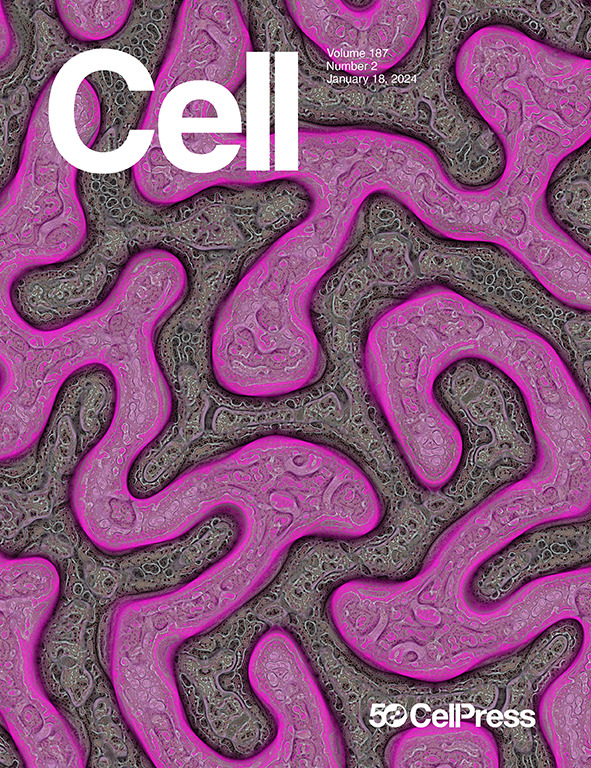Cyclic-dinucleotide-induced filamentous assembly of phospholipases governs broad CBASS immunity
IF 42.5
1区 生物学
Q1 BIOCHEMISTRY & MOLECULAR BIOLOGY
引用次数: 0
Abstract
Cyclic-oligonucleotide-based antiphage signaling systems (CBASS), a widespread antiviral bacterial immune system homologous to the mammalian cGAS-STING pathway, synthesizes cyclic nucleotide signals and triggers effector proteins to induce cell death and prevent viral propagation. Among various CBASS effectors, phospholipase effectors are the first to be discovered and are one of the most widespread families that sense cyclic dinucleotides to degrade cell membrane phospholipids. Here, we report that CBASS phospholipases assemble from a dimeric inactive state into active higher-order filamentous oligomers upon sensing cyclic dinucleotides. Using a combined approach of cryo-electron microscopy and X-ray crystallography, we have determined the structures of CBASS phospholipase in the inactive dimeric state, the cyclic-dinucleotide-bound active higher-order state, and the substrate-analog-bound catalytic mimicry state, thereby visualizing the complete conformational reorganization process. Complemented by functional assays of intermolecular binding, phospholipase enzymatic activity, in vitro membrane disruption, and in vivo antiphage efficiency, our work elucidates the mechanisms of assembly and activation of CBASS phospholipases.

环二核苷酸诱导的丝状磷脂酶组装控制着广泛的CBASS免疫
基于环寡核苷酸的噬菌体信号系统(cyclic -oligonucleotide-based antiphage signaling systems, CBASS)是一种广泛存在的抗病毒细菌免疫系统,它与哺乳动物的cGAS-STING通路同源,通过合成环核苷酸信号并触发效应蛋白来诱导细胞死亡和阻止病毒传播。在各种CBASS效应物中,磷脂酶效应物是最早被发现的,也是分布最广的一类感应环二核苷酸降解细胞膜磷脂的效应物。在这里,我们报告了CBASS磷脂酶在感知环二核苷酸时从二聚体无活性状态组装成活性的高阶丝状低聚物。利用低温电子显微镜和x射线晶体学相结合的方法,我们确定了CBASS磷脂酶在非活性二聚体状态、环-二核苷酸结合活性高阶状态和底物-类似物结合催化模拟状态下的结构,从而可视化了完整的构象重组过程。通过分子间结合、磷脂酶活性、体外膜破坏和体内抗噬菌体效率的功能分析,我们的工作阐明了CBASS磷脂酶的组装和激活机制。
本文章由计算机程序翻译,如有差异,请以英文原文为准。
求助全文
约1分钟内获得全文
求助全文
来源期刊

Cell
生物-生化与分子生物学
CiteScore
110.00
自引率
0.80%
发文量
396
审稿时长
2 months
期刊介绍:
Cells is an international, peer-reviewed, open access journal that focuses on cell biology, molecular biology, and biophysics. It is affiliated with several societies, including the Spanish Society for Biochemistry and Molecular Biology (SEBBM), Nordic Autophagy Society (NAS), Spanish Society of Hematology and Hemotherapy (SEHH), and Society for Regenerative Medicine (Russian Federation) (RPO).
The journal publishes research findings of significant importance in various areas of experimental biology, such as cell biology, molecular biology, neuroscience, immunology, virology, microbiology, cancer, human genetics, systems biology, signaling, and disease mechanisms and therapeutics. The primary criterion for considering papers is whether the results contribute to significant conceptual advances or raise thought-provoking questions and hypotheses related to interesting and important biological inquiries.
In addition to primary research articles presented in four formats, Cells also features review and opinion articles in its "leading edge" section, discussing recent research advancements and topics of interest to its wide readership.
 求助内容:
求助内容: 应助结果提醒方式:
应助结果提醒方式:


